Barrio Logan in San Diego
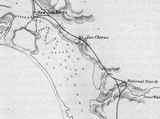 1850 Gray survey
1850 Gray survey
|
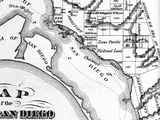 1871 subdivisions
1871 subdivisions
|
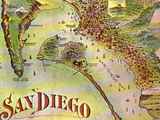 1890 Our Italy
1890 Our Italy
|
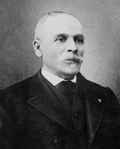 Matthew Sherman
Matthew Sherman
|
1850 - New Town is established on the bay and population began to move south from Old Town
1854 - The San Diego & Gila Railroad was proposed to connect San Diego with one of the possible transcontinental routes being planned after the 1853 Gadsden Purchase; Charles Poole made the first survey of a possible route from Yuma to Otay and north along the bay into New Town
1867 - Alonzo Horton purchased the 960 acres of the 47,324 acres of pueblo lands (confirmed by the U.S. in 1874) and also set aside 1440 acres for a city park; over the next 25 years, 80% of the pueblo lands would be sold to private owners, and other portions would be reserved for attracting a railroad to San Diego
1869 - Matthew Sherman formed a committee "to solicit gifts of land to induce the Memphis and El Paso railroad to locate its terminus in San Diego. That project did not materialize however. The following year, Sherman, along with Alonzo Horton, E. W. Morse and others, organized the San Diego and Los Angeles railroad, a paper corporation with a land grant from the City Trustees with which they hoped to lure a transcontinental railroad to San Diego. In 1871 Sherman went to Washington to lobby for passage of the legislation chartering the Texas and Pacific to build a rail line from Texas to California. While Sherman was in Washington, Congressman John A. Logan worked out the final details of the bill, which provided Federal government land grants and subsidies." It was Logan, incidentally, from whose name San Diego's "Logan Heights" was derived: one of the major streets in a subdivision laid out in 1886 on railroad lands was named for him, and gradually the entire area in southeast San Diego came to be called "Logan Heights." After passage of the Texas and Pacific bill in 1871, Tom Scott, president of the railroad, came to California where he was entertained royally by officials and business leaders in San Francisco, Los Angeles, and San Diego. He finally agreed to establish the terminus of the Texas and Pacific in San Diego in exchange for title to lands previously granted by the City Trustees to other railroad corporations such as the San Diego and Los Angeles, and the San Diego and Gila railroad. Among the lands included in this arrangement were four Pueblo Lots (1158, 1159, 1162 and 1163) immediately southeast of Sherman Heights, covering the area from Commercial Street to the waterfront, between 24th and 32nd Streets. The Texas and Pacific never completed the rail line, for the company was ruined by the stock market crash of 1873. " (5)
1868 - Frank and Warren Kimball purchased 26,632 acres of the old Rancho de la Nacion, called it National City, and laid out a 100-foot wide path six miles long for a railroad; the California Southern Railroad connected with the East in 1885, but the boom of the 1880s ended in 1889 when the Santa Fe decided to make Los Angeles the western terminus rather than San Diego
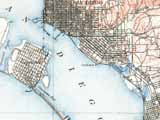 1902 USGS map
1902 USGS map
|
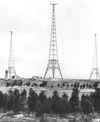 Chollas transmitter
Chollas transmitter
|
1906 - John D. Spreckels led a corporation to build San Diego & Arizona Eastern Railroad to Yuma, finished in 1919 but never successful, abandoned in 1976 after flash flood
1910 - Logan Heights "was once primarily a residential area and one of San Diego's oldest communities. Starting between the years of 1910 and 1920 the area began its transformation into a predominantly Mexican-American community as immigrants fled north from revolution and a poor Mexican economy." (1)
1917 - U.S. Navy built a large radio station in Chollas Heights.
1920 - " Nearly one-half million Mexicans entered the United States on permanent visas during the 1920s, some 11 percent of total U.S. immigration during that decade. Thousands more entered informally, before passage of restrictive regulations. Even after establishment of more stringent immigration rules and procedures, thousands continued to cross without legal sanction. . . By 1930, more than 30 percent of Mexican-born U.S. residents lived in California. They entered nearly every occupation classified as unskilled or semi-skilled. Chicanos became the bulwark of southwestern agriculture. By 1930, manufacturing, transportation, communications, and domestic and personal service had become the other major sectors of Chicano employment. Chicanos made up 75 percent of the work force of the six major western railroads. They also held blue-collar positions in construction, food processing, textiles, automobile industries, steel production, and utilities. In California during the 1920s, Chicanos constituted up to two-thirds of the work force in many industries. A small Chicano middle class developed, often oriented toward serving the Chicano population. The growth of barrios and colonias fostered expansion of small businesses such as grocery and dry-goods stores, restaurants, barber shops, and tailor shops. Small construction firms emerged. Chicanos entered the teaching profession, usually working in private Chicano schools or in segregated public schools." (3)
1921 - "the property on which the present Naval Station is now located was deeded to the government by the City of San Diego on September 3, 1919 for the purpose of building thereon a docking and fleet repair base. The property consisted of 21 water acres and 77.2 land acres, the former being mostly marsh and tide flats. The reclamation work was done by the U.S. Navy and the U.S. Shipping Board and consisted of hydraullic fill from dredging in connection with the preparation of a suitable channel. The concrete ship building plant of the U.S. Shipping Board Emergency Fleet Corporation occupied the land. Of four vessels of 7,500 tons each contracted to be built here, only two, the USS Cuyamaca and the USS San Pasqual, were completed. Due to excessive costs the c/nStracts were cancelled. On February 15, 1921, the Navy acquired the land, buildings and certain machinery from the U.S. Shipping Board, and, on June 10, 1921 the USS Prarie, Commander H.N. Jenson, USN, Commanding was ordered to proceed to the vicinity of the Destroyer Base to take over the property and commence its reorganization pre-paratory to the receipt of the destroyers which were to be placed out of commission. The base was occupied March 1922. Just prior to this, on February 23, 1922, the U.S. Destroyer Base, San Diego, California was offically established by the Secretary of the Navy in General Order No. 78. By the letter part of the year 84 World War I destroyers were located at the base. The primary mission of the Destroyer Base at this time was the upkeep and preservation of the decommissioned destroyers. On May 141, 1930 Congress authorized the exchange of 9.0 acres at the northern extremity of the Destroyer Base for 6.1 acres adjoining the base property and belonging to the City of San Diego. The land acquired by the government in this exchange was located on the water front and was more desireable to the Destroyer Base than that relinquished. After the exchange, the resulting acreage of the base was 94.7 acres." (2)
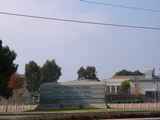 32nd Street Navy gate
32nd Street Navy gate
|
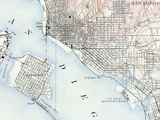 1930 USGS map
1930 USGS map
|
1930 - "In the early 1930s, Chicanos established some 40 agricultural unions in California. The largest, El Confederacion de Uniones de Campesinos y Obreros Mexicanos (CUCOM, Confederation of Mexican Farm Workers' and Laborers' Unions), created in 1933, ultimately included 50 locals and 5,000 members. Most of these unions later joined the American Federation of Labor or the Congress of Industrial Organizations. The Great Depression brought a dramatic population reversal among Mexican Americans. Tabulated immigration to the United States from Mexico fell from nearly 500,000 during the 1920s to only 32,700 during the 1930s. At the same time, official figures indicate that some half- million persons of Mexican descent moved to Mexico." (3)
1938 - WPA built a pier and community beach along the bayfront
1940 - " By 1940 Logan Heights had grown into one of the largest Mexican-American communities on the West Coast, containing fifteen percent of San Diego's Spanish- speaking population. At this time the barrio extended to the waterfront where there was a local beach and community pier which served as a social gathering place. Barrio Logan lost this access to the waterfront, however, when World War II began and the Navy and defense industries moved in along the bay. To many longtime residents of Logan Heights, this was viewed as the first step taken by outside forces that would result in the dismantling of their community." (1)
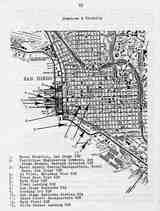 military bases from Hinds
military bases from Hinds
|
1941 - "The Destroyer Base was placed under the Commandant of the 11th Naval District for wartime operation in March 1941. By 1943 a total of 659 land and 262 water acres was included within the boundries of the base property. Facilities were greatly increased during this period. On October 19, 1943 the desigantion of the U.S. Destroyer Base was offically changed to the U.S. Naval Repair Base and as such became a component of the U.S. Naval Base, San Diego. During the period from 1943 until the close of hostilities in 1945 more then 1,500 officers and 41,500 enlisted men had been received and trained for repair duties. During the same period 5,117 ships were sent to the Repair Base for conversion, overhaul, and maintenance, including the repair of battle damage. During the final year of hostilities 28,000 officers and enlisted personnel were on duty at the Naval Repair Base. On September 15, 1946, the U.S. Naval Repair Base was by order of the Secretary of the Navy, redesignated the United States Naval Station, San Diego,. California." (2)
1942 - "The turnaround from the labor surplus of the 1930s to the labor shortage of the 1940s had a special impact on agriculture and transportation. For help, the United States turned to Mexico, and in 1942 the two nations formulated the Bracero Program. From then until 1964, Mexican braceros were a regular part of the U.S. labor scene, reaching a peak of 450,000 workers in 1959. Most engaged in agriculture; they formed 26 percent of the nation's seasonal agricultural labor force in 1960. Along with opportunities, World War II also brought increased tensions between Chicanos and law-enforcement agencies. Two events in Los Angeles brought this issue into focus. In the Sleepy Lagoon case of 1942-1943, 17 Chicano youths were convicted of charges ranging from assault to first-degree murder for the death of a Mexican American boy discovered on the outskirts of the city. Throughout the trial, the judge openly displayed bias against Chicanos, and allowed the prosecution to bring in racial factors. Further, the defendants were not permitted haircuts or changes of clothing. In 1944, the Sleepy Lagoon Defense Committee obtained a reversal of the convictions from the California District Court of Appeals, but the damage had been done." (3)
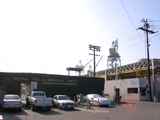 NASSCO
NASSCO
|
1945 - NASSCO was founded in 1905 as California Iron Company, moved to the waterfront in 1944 as National Iron Co., began building ships in 1945, changed its name to NASSCO in 1949
1950 - "Throughout the 1940s and into the 1950s, however, Barrio Logan remained California's second largest Mexican-American community. At one time, this neighborhood was home to nearly twenty thousand residents. This would soon begin to change. As San Diego's downtown area expanded, the city of San Diego and the state of California began to take steps toward modernization. Consequently, the makeup of Barrio Logan completely changed. In the 1950s, city zoning laws were changed turning Logan into an industrial area rather than a residential one. The neighborhood immediately experienced an influx of Anglo-owned junkyards. These auto junkyards were set up next to school yards and homes, creating resentment in the community. To this day, there exists an antagonistic relationship between those affiliated with the junkyards and the residents of Logan." (1)
1962 - Cesar Chavez founded the National Farm Workers Union. "At the age of thirty-five, he left his own well paid job to devote all his time to organizing the farm workers into a union. His wife had to become a fruit picker in the fields to feed their children. Chavez traveled from camp to camp organizing the workers. In each camp, he recruited a few followers. By this time he had also gotten many other members of his family involved in the movement. At the end of six months, 300 members of the National Farm Workers Union, as the group was first called, met in Fresno, California. At that first meeting, they approved their flag, a red background with a black eagle in a white circle in the center. "La Causa" (The Cause) was born! With a strong leader to represent them, the workers began to demand their rights for fair pay and better working conditions. Without these rights, no one would work inthe fields. A major confrontation occurred in 1965. The grape growers didn't listen to the union's demands, and the farmhands wanted a strike.
At first, Chavez wanted to avoid a strike, but he was finally convinced that there was no other way. The workers left the fields, and the unharvested grapes began to rot on the vines. The growers hired illegal workers and brought in strikebreakers and thugs to beat up the strikers. The dispute was bitter. Union members-Chavez included- were jailed repeatedly. But public officials, religious leaders, and ordinary citizens from all across the United States flocked to California to march in support of the farm workers. Then, in 1970, some grape growers signed agreements with the union. The union lifted the grape boycott, and its members began to pick grapes again. That same year, chavez thought that even people who could not travel to California could show their support for his cause. Thus he appealed for a nationwide boycott of lettuce. People from all parts of the United States who sympathized with the cause of the farm workers refused to buy lettuce. Some even picketed in front of supermarkets." (4)
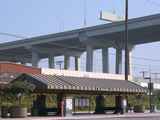 bridge and trolley
bridge and trolley
|
1963 - Interstate 5 was constructed and divided the community.
1969 - The San Diego-Coronado Bay Bridge opened after two years construction; the population declined from 20,000 to 5000 in the next 10 years
1969 - "During the late 1960s and early 1970s, the United States was in the midst of massive social change that would find its way to Barrio Logan. The black civil rights movement had inspired many emerging leaders of the Chicano community. Then in the 1960s the United Farm Workers movement led by Cesar Chavez sparked a new political awareness in Chicanos everywhere. Among many other events, student organizations such as MECHA (Movimiento Estudiantil Chicano de Aztlan) were formed. Young Chicanos were creating a political movement that was all their own. This
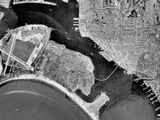 1970 aerial photo
1970 aerial photo
|
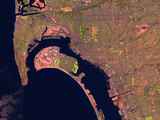 1996 LandSat 5 photo
1996 LandSat 5 photo
|
Chicano youth movement culminated in March of 1969 when the first National Chicano Youth Conference was held in Denver, Colorado. Over fifteen hundred young people attended, including several of the young artists who would later become some of the original muralists of Chicano
Park. The conference created a document known as El Plan Espirutual de Aztlan or "The Spiritual Plan of Aztlan." This plan called for Chicano youths to create political and social planning at the grass roots level. It also called for Chicano artists to become active participants in the social and political causes of their communities. Those who had attended the conference returned to their own neighborhoods excited by the way the meeting in Denver had affirmed their Chicano culture." (1)
1970 - April 22, Chicano Park occupied by area residents
1981 - San Diego Trolley was dedicated in 1980, built on the rail line of the defunct San Diego and Arizona Railroad; in 1981 began service south to the border, stopping at Barrio Logan
1989 - San Diego Convention Center opened on Harbor Drive
1990 - Barrio Logan population at 13,488; 44 percent live below the poverty level
1993 - Communites At Risk report published by Environmental Health Coalition, identifying Barrio Logan as a toxic waste disposal site
Sources:
- A Turning Point: The Conception and Realization of Chicano Park by Kevin Delgado
- Hinds, James W. "San Diego's Military Sites," typed mss, San Diego Historical Society, 1986, pp. 120-122.
- A History of Mexican Americans in California by NPS
- Bracero Program from Sin Fronteras
- Cesar Chavez biography from Cesar E. Chavez Institute for Public Policy
- Matthew Sherman by Clare Crane, Journal of San Diego History, Vol 18, Number 4, 1972
- Barrio Logan Fact Sheet from Environmental Health Coalition
- Environmental Justice Case Study: Industrial Pollution in Barrio Logan identified the Kelco Corp., located next to the Perkins Elementary School, as a major polluter
- Barrio Logan pictures and links and maps